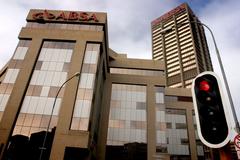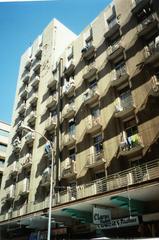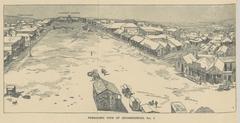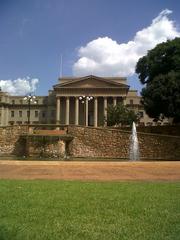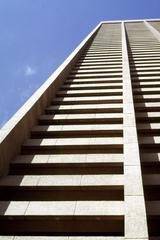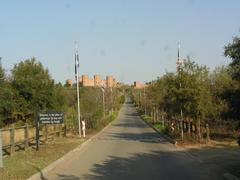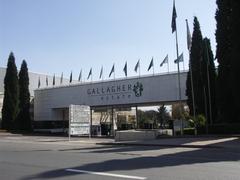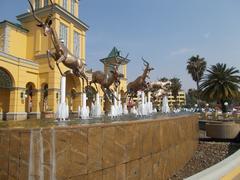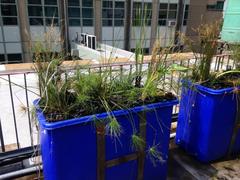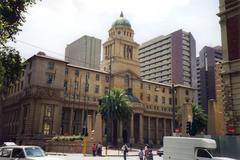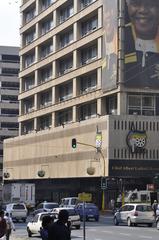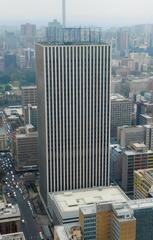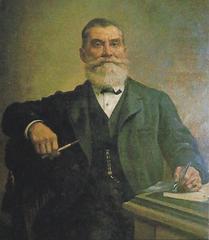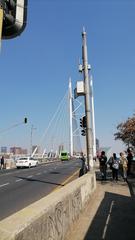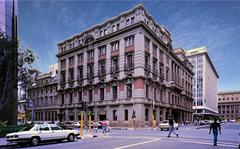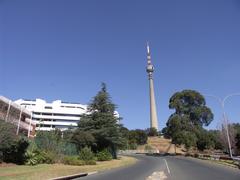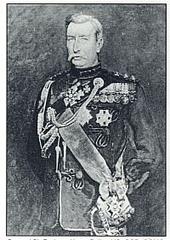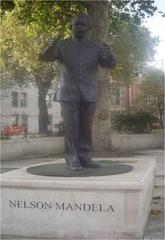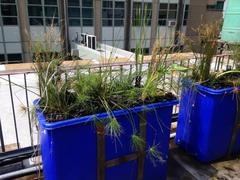Hillbrow Tower Visiting Hours, Tickets, and Travel Guide: Johannesburg Historical Sites
Date: 14/06/2025
Introduction: Hillbrow Tower – A Johannesburg Icon
Rising above the dynamic heart of Johannesburg, South Africa, the Hillbrow Tower is an enduring symbol of the city’s ambition, transformation, and resilience. Completed in 1971 and originally known as the JG Strijdom Tower, this telecommunications marvel—now called the Telkom Jo’burg Tower—held the title of Africa’s tallest structure for decades, reaching 269 meters (883 feet). Though closed to the public for over forty years, the tower’s striking silhouette remains a focal point of the city’s skyline and a testament to Johannesburg’s evolving urban identity (Johannesburg1912; Trek Zone; Wikipedia).
This detailed guide covers the Hillbrow Tower’s architectural significance, historical and cultural impact, practical visitor information—including its current access status and safety tips—and nearby attractions. Whether you’re a history enthusiast, urban explorer, or first-time visitor, this resource will help you appreciate why Hillbrow Tower is much more than just a telecommunications structure.
Contents
- Hillbrow Tower: History and Origins
- Architectural and Urban Significance
- Cultural Impact and Contemporary Identity
- Visiting Hillbrow Tower: Hours, Tickets & Access
- Accessibility, Safety, and Visitor Tips
- Nearby Attractions for a Complete Johannesburg Experience
- FAQ: Essential Visitor Information
- Conclusion: Embracing Johannesburg’s Heritage
- Sources
Hillbrow Tower: History and Origins
The Hillbrow Tower was envisioned as a solution to Johannesburg’s rapidly growing telecommunications demands in the late 1960s. Construction began in June 1968 and concluded by April 1971, with the project costing approximately 2 million Rand (Johannesburg1912). Commissioned by the South African Posts and Telecommunications (SAPT), the tower became a central node for radio, television, and telephone signals, reinforcing Johannesburg’s position as a modern African metropolis (aluxurytravelblog.com).
Originally named after apartheid-era Prime Minister JG Strijdom, the structure was later renamed Telkom Jo’burg Tower in 2005, aligning with South Africa’s post-apartheid push for a more inclusive national identity (Trek Zone).
Architectural and Urban Significance
Design and Construction
Designed by architect Jan Heineken, the Hillbrow Tower is a pinnacle of late-1960s modernism. Its 269-meter reinforced concrete shaft is topped by six public floors, which once housed a revolving restaurant, discotheque, and observation deck (Design Indaba). The restaurant, known as Heinrich’s, was a technological marvel in its own right, rotating once every hour and accommodating over 100 guests.
The tower’s tapering design minimizes wind resistance, and its deep foundation anchors it securely against Johannesburg’s notorious highveld weather (Wikipedia). Its height was carefully calculated to ensure unobstructed telecommunications signals above the burgeoning city.
Urban Landmark
Together with the nearby Sentech Tower, the Hillbrow Tower defines Johannesburg’s skyline. Its illuminated presence is a familiar sight in postcards, artwork, and popular media, symbolizing both the city’s economic ambitions and its enduring spirit (Evendo).
Cultural Impact and Contemporary Identity
From Apartheid Ambition to Urban Renewal
Erected during the apartheid era as a showcase of state power and modernity, the Hillbrow Tower quickly became entwined with the identity of its neighborhood. Hillbrow itself transformed from a fashionable, cosmopolitan suburb in the early 20th century to a multicultural hub and, eventually, a symbol of urban decline and resilience (BMC Public Health).
During the 1970s and 1980s, Hillbrow was Johannesburg’s first deracialized residential area, a haven for social experimentation and activism, including the city’s organized LGBTQ+ movements (BMC Public Health). However, the 1990s brought economic hardship and urban decay, with the neighborhood becoming associated with crime and overcrowding.
Despite these challenges, the Hillbrow Tower has remained a powerful symbol of Johannesburg’s adaptability. It frequently appears in art, photography, and media, and was famously decorated with a giant football during the 2010 FIFA World Cup (Wikipedia).
Community Engagement and Public Memory
Although closed to the public since 1981, the tower remains a focal point for guided walking tours, such as those offered by the Dlala Nje Foundation, which celebrate Hillbrow’s vibrancy and ongoing renewal (Dlala Nje; Africanews).
Visiting Hillbrow Tower: Hours, Tickets & Access
Current Access Status
Hillbrow Tower is not open to the public. The observation deck and revolving restaurant have been closed since 1981 due to security concerns. There are no visiting hours or tickets available for entry into the tower (Wikipedia).
Alternative Ways to Experience the Tower
- Guided Walking Tours: Several local organizations, including Dlala Nje, offer safe, informative tours that explore Hillbrow’s history, architecture, and street life with the tower as a highlight (Dlala Nje).
- Photography: The tower is easily photographed from surrounding neighborhoods and key city vantage points.
Accessibility, Safety, and Visitor Tips
Getting There
The Hillbrow Tower is located at 1 Banket Street, Hillbrow, just northeast of the Johannesburg CBD. While the area is accessible via public transport, taxis, and ride-hailing apps, it is best to visit as part of an organized group or guided tour (aluxurytravelblog.com).
Safety Considerations
Hillbrow is a vibrant yet challenging neighborhood with higher crime rates than other parts of Johannesburg. To ensure a positive experience:
- Visit only during daylight hours.
- Avoid walking alone; join a guided tour for safety and deeper insight.
- Use reputable transportation and avoid displaying valuables.
Practical Tips
- When to Visit: Johannesburg’s climate is mild year-round. Winter (May-August) offers clear skies; spring and autumn are also ideal.
- Where to Stay: Most visitors opt for hotels in Sandton, Rosebank, or Melrose, which are safer and offer easy access to city attractions (africafevers.com).
Nearby Attractions for a Complete Johannesburg Experience
Combine your Hillbrow Tower outing with these top attractions:
- Constitution Hill: Historic site and museum with panoramic city views.
- Apartheid Museum: Essential for understanding South Africa’s history.
- Market Theatre: Renowned cultural and performance venue.
- Maboneng Precinct: Vibrant area for art, dining, and nightlife.
Each site offers further insight into Johannesburg’s heritage, making for a rich and varied itinerary (aluxurytravelblog.com).
FAQ: Essential Visitor Information
Q: Can I visit inside Hillbrow Tower?
A: No, the tower has been closed to public access since 1981 due to safety concerns.
Q: Are there guided tours including Hillbrow Tower?
A: Yes, local operators like Dlala Nje offer walking tours of Hillbrow that feature the tower as a highlight (Dlala Nje).
Q: What are the best viewing spots?
A: Constitution Hill, Four Seasons Hotel at Westcliff, and the City Sightseeing Bus all provide excellent vantage points.
Q: Is Hillbrow safe for tourists?
A: Exercise caution, visit during daylight, join guided tours, and avoid walking alone.
Q: Are there any virtual tours or special events?
A: No official virtual tours or public events are available as of June 2025.
Conclusion: Embracing Johannesburg’s Heritage
Though you cannot enter the Hillbrow Tower, its presence is central to Johannesburg’s story of innovation, adversity, and renewal. By exploring the surrounding neighborhood safely—especially with a knowledgeable guide—you gain insight into the city’s past and present. Pair your visit with other historic and cultural sites for a memorable experience of Johannesburg’s complex charm.
For up-to-date travel tips, curated tours, and safety information, download the Audiala app and follow us on social media.
Sources
- Johannesburg1912 History of Hillbrow
- Trek Zone Hillbrow Tower
- Design Indaba Hillbrow Tower
- Wikipedia Hillbrow Tower
- Evendo Hillbrow Tower Landmark
- Dlala Nje This is Hillbrow Walking Tour
- Africanews Hillbrow Tourism
- aluxurytravelblog.com Johannesburg Guide
- BMC Public Health Hillbrow History
- News24 Hillbrow Heritage

